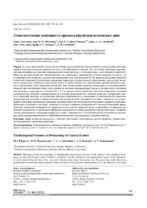| dc.contributor.author | Филонова, М. И. | |
| dc.contributor.author | Диас Гонсалес, Р. О. | |
| dc.contributor.author | Сухоцкий, А. А. | |
| dc.contributor.author | Козерук, А. С. | |
| dc.contributor.author | Семчёнок, А. В. | |
| dc.coverage.spatial | Минск | ru |
| dc.date.accessioned | 2020-12-01T12:08:12Z | |
| dc.date.available | 2020-12-01T12:08:12Z | |
| dc.date.issued | 2020 | |
| dc.identifier.citation | Технологические особенности процесса обработки конических линз = Technological Features in Processing of Conical Lenses / М. И. Филонова [и др.] // Наука и техника. – 2020. – № 6. – С. 521-527. | ru |
| dc.identifier.uri | https://rep.bntu.by/handle/data/82026 | |
| dc.description.abstract | В статье представлена технология получения плоскоконических линз (аксиконов) методом свободного притирания заготовки к плоскому инструменту через слой абразивной суспензии. Для этого были проведены теоретико-экспериментальные исследования закономерностей съема припуска с основания конуса и его боковой поверхности. Выявлены режимы обработки, обеспечивающие как равномерное срабатывание плоской поверхности детали, так и усиленный съем припуска в краевой или центральной зоне этой поверхности. Во время исследований обработки конической поверхности установлены наладочные параметры технологического оборудования, при которых имеют место минимальное отклонение образующей конуса от прямолинейности и максимальная производительность процесса. Предложены этапы обработки конических линз, позволяющие назначить оптимальную последовательность операций при изготовлении такого типа деталей из заготовок цилиндрической формы в случаях, когда отношение высоты конуса к диаметру его основания H/d 0,5. К главным этапам обработки относятся: шлифование оснований цилиндрических заготовок с выдерживанием их взаимной параллельности с заданной точностью; полирование одного из оснований цилиндра до достижения требуемых шероховатости и отклонения от неплоскостности; крепление цилиндрической заготовки к вспомогательной плоскопараллельной стеклянной пластинке с помощью сил молекулярного сцепления; механическое крепление цилиндрической заготовки цанговой переходной оправкой за плоскопараллельную стеклянную пластинку; нанесение на второе основание цилиндрической заготовки ближайшей сферы; нанесение конической поверхности на сферическую часть плоско-выпуклой линзы; шлифование и полирование конической поверхности до достижения требуемых шероховатости и прямолинейности образующей конуса. Выявлена степень эффективности наладочных параметров станка в зависимости от технологической наследственности заготовки с точки зрения распределения по обрабатываемой поверхности подлежащего удалению припуска. | ru |
| dc.language.iso | ru | ru |
| dc.publisher | БНТУ | ru |
| dc.title | Технологические особенности процесса обработки конических линз | ru |
| dc.title.alternative | Technological Features in Processing of Conical Lenses | ru |
| dc.type | Article | ru |
| dc.identifier.doi | 10.21122/2227-1031-2020-19-6-521-527 | |
| local.description.annotation | The paper presents the technology of obtaining flat-conical lenses (axicons) by the method of free grinding a workpiece to a flat tool through a layer of abrasive suspension. For this, theoretical and experimental studies of the regularities of stock removal from the base of the cone and its lateral surface have been carried out. The processing modes have been identified that ensure both uniform operation of the flat surface of the part and enhanced removal of the allowance in the edge or central zone of this surface. During the study of the processing of the conical surface, the set-up parameters of the technological equipment have been established, at which there is a minimum deviation of the generatrix of the cone from straightness and maximum productivity of the process. The stages of processing conical lenses are proposed, which allow to assign the optimal sequence of operations in the manufacture of this type of parts from blanks of a cylindrical shape in cases where the ratio of the height of the cone to the diameter of its base H/d 0.5. The main stages of processing include: grinding of the bases of cylindrical blanks with maintaining their mutual parallelism with a given accuracy; polishing one of the cylinder bases to achieve the required roughness and deviation from non-flatness; fastening a cylindrical blank to an auxiliary planeparallel glass plate using molecular cohesion forces; mechanical fastening of a cylindrical work-piece with a collet adapter mandrel for a plane-parallel glass plate; applying the nearest sphere to the second base of the cylindrical blank; drawing a conical surface on the spherical part of a plano-convex lens; grinding and polishing the conical surface to achieve the required roughness and straightness of the cone generatrix. The degree of efficiency of the setup parameters of the machine has been revealed depending on the technological heredity of the work-piece from the point of view of the distribution of the allowance to be removed over the machined surface. | ru |

